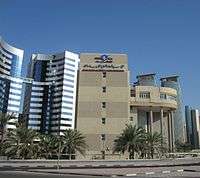Kahramaa
Kahramaa (Qatar General Electricity and Water Corporation), was established in July 2000 to regulate and maintain the supply of electricity and water for the population of Qatar.[2] Since inception, Kahramaa has operated as an independent corporation on a commercial basis with a total capital of eight billion Qatari riyals. Kahramaa is the sole transmission and distribution system owner and operator for the electricity and water sector in Qatar.
 Kahramaa's building in Doha, Qatar. | |
| Public | |
| Industry | Energy Water |
| Founded | 2000 |
| Headquarters | , |
Area served | State of Qatar |
Key people | Abdullah bin Hamad Al Attiyah (Chairman)[1] |
| Products | Electricity Water |
| Services | Utility provider |
| Website | www |
History
During Qatar's years as a British protectorate in the 20th century, water and electricity was regulated by the British under two separate entities known as the State Electricity Department and the State Water Department.[2] After the British announced their plans of withdrawing from the country in 1968, the state established the Ministry of Electricity and Water to regulate its electricity and water needs.[2] In July 2000, the Qatar General Electricity and Water Corporation (Kahramaa) was established by emiri decree in order to regulate and maintain the supply of water and electricity for the Qatari population.[2]
Operations
In August 2015, the company announced that it would begin construction of Umm al Houl Power, a desalination and power plant in the south of the country. The plant started its operations from July 2018.[3] The construction was estimated to cost around $2.75 billion and will have a capacity of 2520 MW and 136 million imperial gallons (620,000 m3) of potable water a day.[4]
Qatar's first major solar power plant was announced by Kahramaa in 2014, and is slated to begin operations by 2016. Its production capacity is expected to be 15 MW.[5] In December 2015, the company stated that it had signed an agreement with Qatar Petroleum for cooperation in the development of solar power plants. Kahramaa would retain 60% ownership of the plants constructed under the agreement, while Qatar Petroleum would retain the remaining 40%.[6]
Electricity sector
As of 2011, the electricity transmission networks consist of approximately 247 primary high voltage sub-stations.[7] The network is coupled with 10500 low and medium voltage sub-stations (11 kV). Its voltage sub-stations are supported by a total 4000 km of overhead lines and 8,500 kilometres (5,300 mi) of underground cables running across the country.[7] The National Control Center manages all network demand and data acquisition from generation plants and primary sub-stations.
Electricity generation
Generation of electrical energy in Qatar has increased over the past fifty years; the maximum load over the network during the period from 1988 to 2003 has risen from 941 MW to 2,312 MW. It reached 3,230 MW in 2006. By 2011, it had increased to 6,518 MW.[7] The company was producing around 8,600 MW by 2014; a 2,000 MW surplus when compared to the 6,600 MW of demand.[8]
Electricity generation capacity
Kahramaa's electricity generation capacity was 28,144 GWh in 2010. This figure increased to 30,730 GWh in 2011 and 34,788 GWh in 2012 before dropping slightly, to 34,688 GWh in 2013. Another large expansion was recorded in 2014, when the electricity production capacity was raised to 38,963 GWh. Overall, from 2010 to 2014, Kahramaa's electricity generation capacity was increased at an average annual rate of around 10%.[9]
Water sector
The water network in Qatar has been expanded extensively in recent years, the growth of urban areas; industry and agriculture has led to the increase in the length of the water network to 3,622 kilometres (2,251 mi) and expansion in the number of storage reservoirs to 23 with a total capacity of 259 million imperial gallons (1,180,000 m3) of potable water a day.
Water capacities
Statistical data in the water sector shows a remarkable growth in the capacities of water storage facilities. Such an increase has amounted to 259 million imperial gallons (1,180,000 m3) a year in 2006, in comparison to less than 200 million imperial gallons (910,000 m3) in 1988. The annual water capacity was recorded as 822 million imperial gallons (3,740,000 m3) in 2009 and by 2014 had increased to 1,088 million imperial gallons (4,950,000 m3).[9]
Water quality
To ensure safe and clean drinking water to high standards and quality, water is subject to daily random bacteriological and laboratory tests undertaken by Kahramaa. Samples are collected and tested from the storage reservoirs and networks up to the customers' storage facilities.
References
- "Qatar Electricity and Water Company". Arabian Business. Retrieved 9 July 2015.
- "Qatar General Electricity & Water Corporation". Industry ME. Retrieved 9 July 2015.
- "Umm Al Houl Plant to be operational in July". thepeninsulaqatar.com. Retrieved 2019-04-23.
- "Qatar utility says to build $2.75 billion power and water plant". India Times. 11 August 2015. Retrieved 11 August 2015.
- Lesley Walker (18 November 2014). "Kahramaa to open Qatar's first major solar power plant by 2016". Doha News. Retrieved 12 August 2015.
- "Qatari state firms agree to invest in solar power". Daily Sabah. 25 December 2015. Retrieved 25 December 2015.
- "Qatar General Electricity & Water Corporation (Kahramaa) - Report" (PDF). MEED Insight. Retrieved 10 July 2015.
- Manar Zoheir (1 August 2014). "Kahramaa Powering Ahead". BQ Magazine. Retrieved 25 December 2015.
- "Average electricity generation grows by 10% in Qatar". Gulf Times. 8 October 2015. Retrieved 9 October 2015.